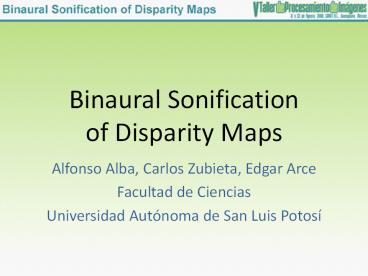Binaural Sonification of Disparity Maps - PowerPoint PPT Presentation
1 / 15
Title:
Binaural Sonification of Disparity Maps
Description:
Images from a stereo camera pair will be used to detect objects in the scene and ... Stereo image acquisition. Disparity map estimation. Disparity map ... – PowerPoint PPT presentation
Number of Views:56
Avg rating:3.0/5.0
Title: Binaural Sonification of Disparity Maps
1
Binaural Sonificationof Disparity Maps
- Alfonso Alba, Carlos Zubieta, Edgar Arce
- Facultad de Ciencias
- Universidad Autónoma de San Luis Potosí
2
Contents
- Project description
- Estimation of disparity maps
- Segmentation of disparity maps
- Object sonification
- Test application
- Preliminary results
- Future work
3
Project description
- The goal of this project is to develop a scene
sonification system for the visually impaired. - Images from a stereo camera pair will be used to
detect objects in the scene and estimate the
distance between them and the subject. - A binaural audio signal will be synthesized for
each object, so that the subject can hear the
objects in the scene in their corresponding
locations.
4
Scene sonification system
- The system will consist of the following stages
- Stereo image acquisition
- Disparity map estimation
- Disparity map segmentation (object detection)
- Binaural sonification of objects in the scene
- Here we will focus only on the segmentation of a
given disparity map, and sonification stages.
5
Estimation of disparity maps
- Images from a pair of cameras, separated by a
certain distance, form a stereo image pair. - The position of a certain object in one of the
images will be shifted in the other image by an
amount inversely proportional to the distance
between the object and the camera arrangement. - This displacement is called disparity, and can be
computed for each pixel to form a disparity map. - We are currently working on a technique to
compute disparity maps in realtime.
6
Segmentation of disparity maps
- Given a disparity map D(x,y), we perform a seeded
region-growing segmentation to detect the objects
in the scene. - To choose the seeds, the algorithm uses a fitness
measure given bywhere N(x,y) is the set of
nearest-neighbors of (x,y), and q is a quality
parameter (increases robustness to noise). - This measure favors homogeneous regions (low
dq)with the highest disparity (nearest objects).
7
Region-growing algorithm
- The algorithm performs the following steps
- Choose the pixel (x,y) with highest fitness,
add it to a queue Q, and label it with a new
region label k. - Let rk D(x,y) be the representative value for
region k. - While Q is not empty, do
- Pull the first pixel (x,y) in Q
- For each unlabeled neighbor (x,y) of (x,y) such
that rk - D(x,y) lt e, add (x,y) to region
k and to the queue Q. - Recompute rk as the average disparity of the
pixels in region k.
8
Object sonification
- Sound coming from a specific location will suffer
a series of degradations before it reaches our
ears. - These degradations provide various cues that our
brain uses to locate the sound sorce. - Binaural spatialization attempts to model these
cues, in order to allow the listener to hear a
sound as if it were coming from a specific point
in space, which is typically defined in spherical
coordinates (see below).
9
Object sonification
- We represent each object in the scene with a
ping-like sound whose frequency depends on the
disparity, so that the sound becomes more
alerting as the object becomes closer. - The audio signal corresponding to each object is
fed through a binaural spatialization system
whose parameters depend on the objects
position. - Spatialization is performed by modeling azimuth
and range cues. Elevation cues have not been
implemented (yet).
10
Azimuth cues
- Inter-aural Time Difference
- The sound source is delayed by a different amount
for each ear - Tn a a sin(q), Tf a at.
- Inter-aural Level Difference (head-shadow)
- The sound is attenuated when passing through the
head. - This cue can be modeled with a one-pole one-zero
filter
Brown et al., 1998
11
Range cues
- Artificial Reverberation
- Reverberation is the result of a large number of
echoes originated from the reflection of the
sound in flat surfaces such as walls. - The level of reverberation is roughly constant
and independent of source location. - We use a simple model composed of 4 parallel
delay lines with feedback. - Attenuation
- The audio signal is attenuated according to the
inverse quadratic law. - The ratio between the signal and reverberation
levels provides an additional cue for range.
12
Test application
- We simulate a moving scene by taking a 160 x 100
sub-frame of a precomputed disparity map. - The 10 most relevant objects are segmented but
only objects that are near enough are sonified.
13
Preliminary results
- Fast segmentation times
- 5 ms per 160 x 100 frame in a 2.4 GHz dual core
CPU - Over 100 frames per second including sonification
stage (but without disparity map estimation) - Embedded implementation is viable
- Good azimuth representation object direction is
easily perceived. - Object range is perceived in a relative manner
(e.g., one object is nearer than another), but
not in an absolute way. - Between 3 and 5 objects can be sonified before
too much clutter is heard.
14
Future work
- Camera setup and calibration
- Realtime estimation of disparity maps
- Elevation cues in binaural spatialization
- Optimization of sonification system
- Implementation in an embedded device
15
Thank you!

